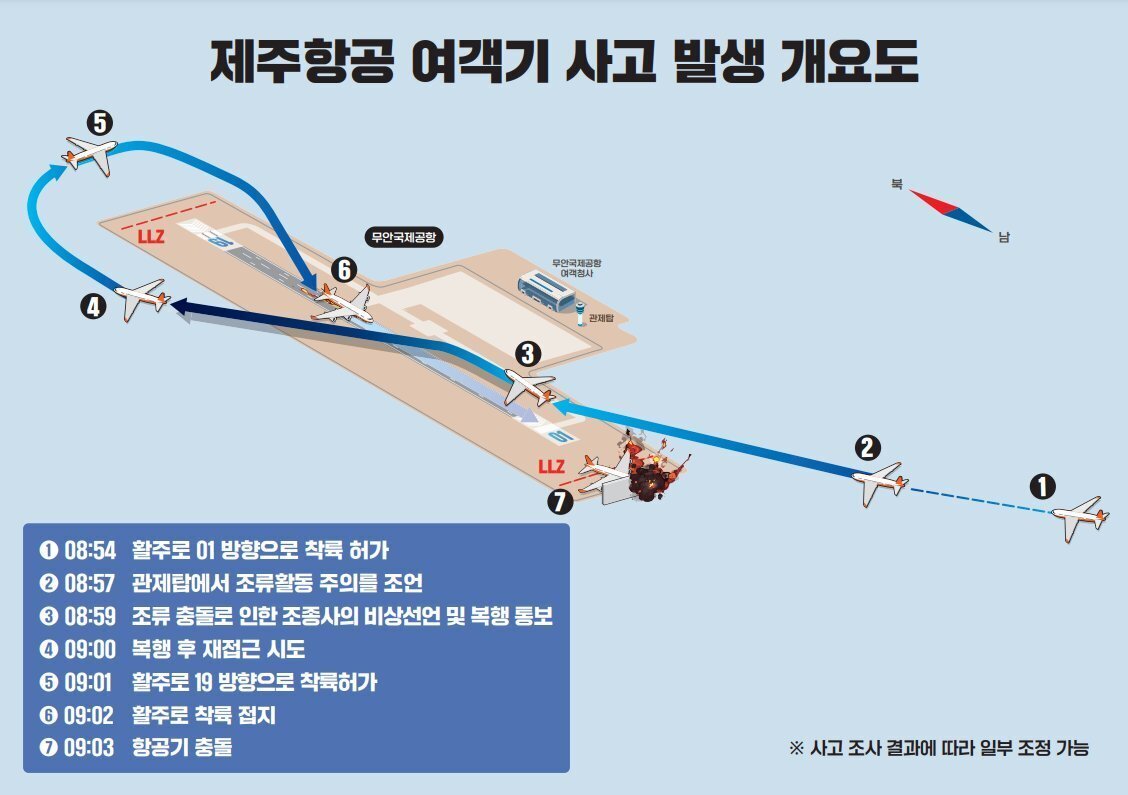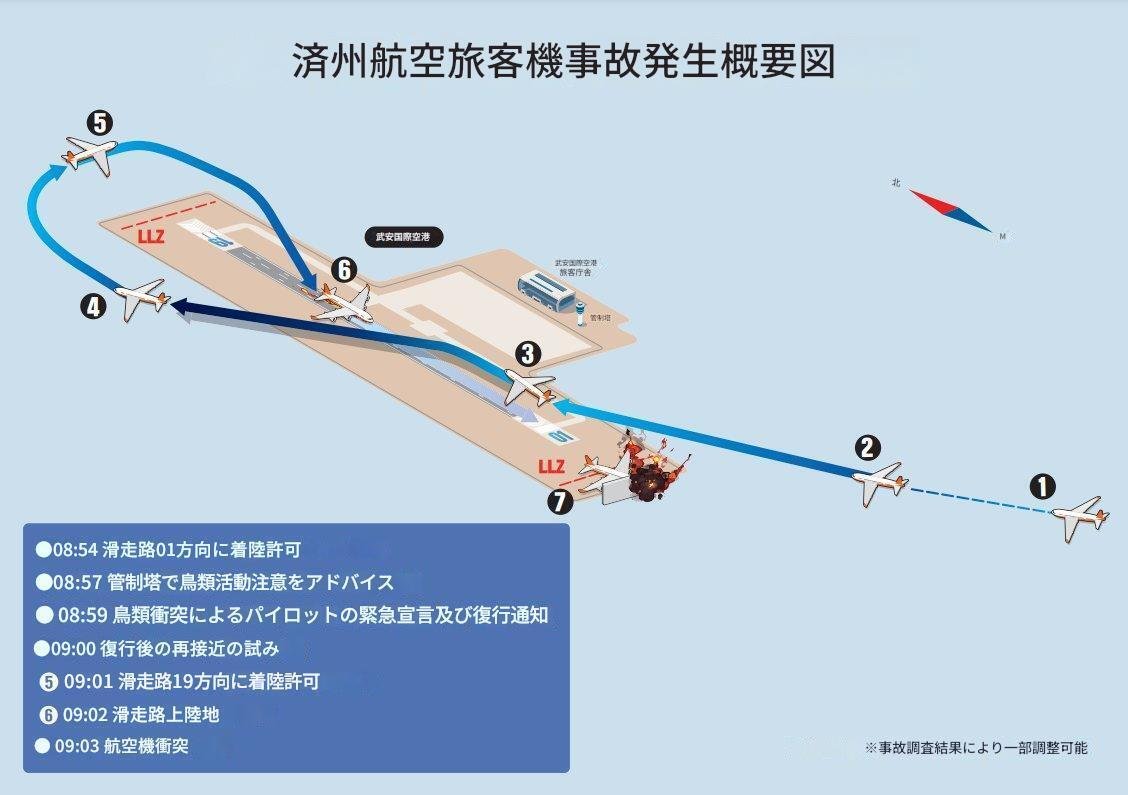
ムアン国際空港に胴体着陸した737がゴーアラウンド時に一旦格納した車輪を再着陸時に出し忘れた可能性は?(チェジュ航空2216便)補遺:着陸直前のバードストライク(ローマの奇跡)離陸直後のバードストライク(ハドソン川の奇跡・ラメンスコエ(とうもろこし畑)の奇跡)
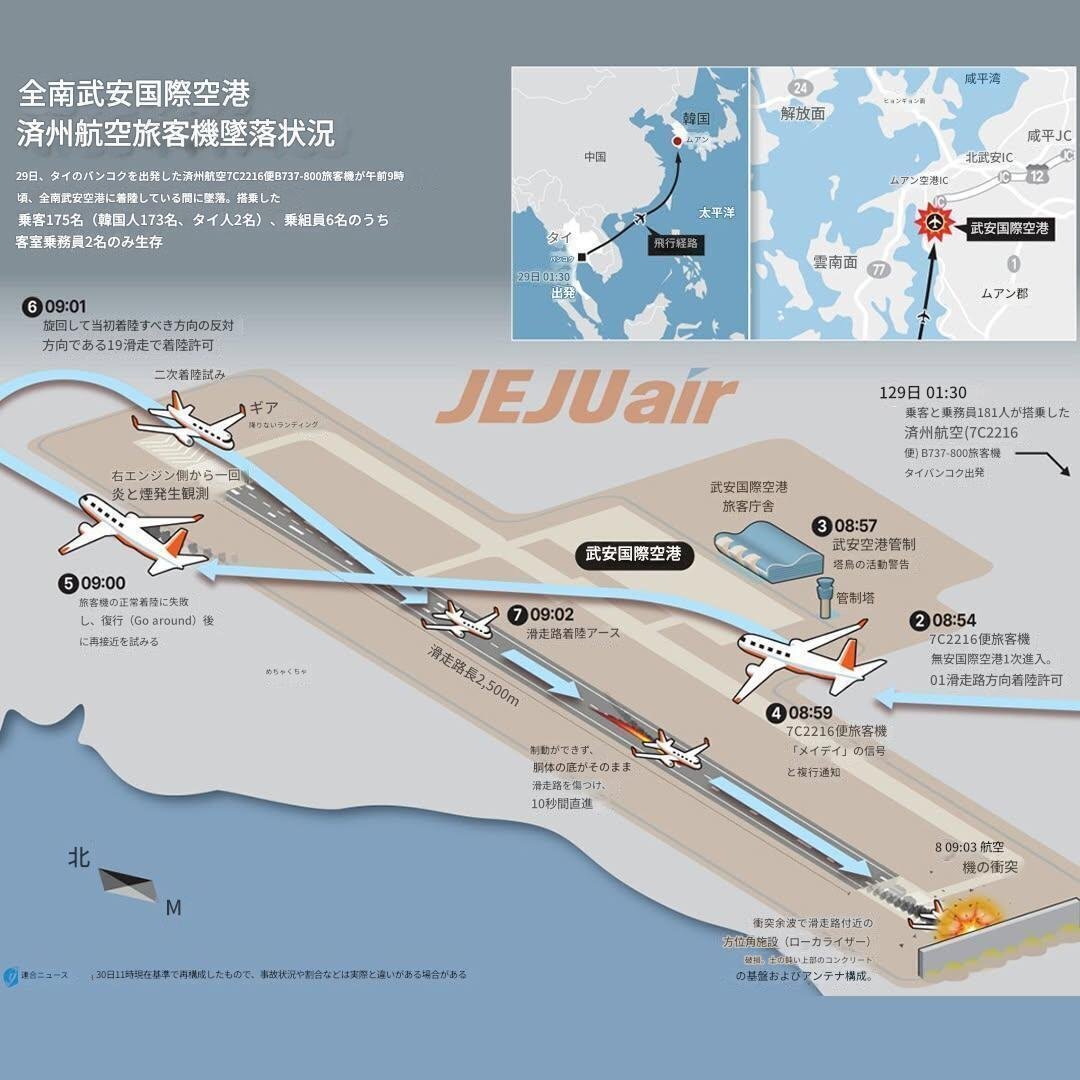
二つ前の記事
では昨年末に務安国際空港に胴体着陸したチェジュ航空2216便の機長と副操縦士に対する批判的な意見は紹介しませんでしたが、滑走路の南側からアプローチしている最中にバードストライクで損傷した第2エンジン(右側のエンジン)を停止(?)しながら(電気系統や油圧系統はどうにか機能していたので)片肺飛行で急上昇・急旋回して滑走路の北側から(再度)着陸を試みる際にランディングギアを降ろすのを忘れたのではないかという説が目に留まりました。念のため、この記事の末尾に引用します。
仮説に過ぎませんが、(機長と副操縦士が力を尽くした結果)機体は滑走路の中央にスムースに胴体着陸したようなので、電気系統や油圧系統は機能していたのではないかという推論は正しいのかもしれません。コックピットの音声記録やフライトレコーダーの解析が待たれます。
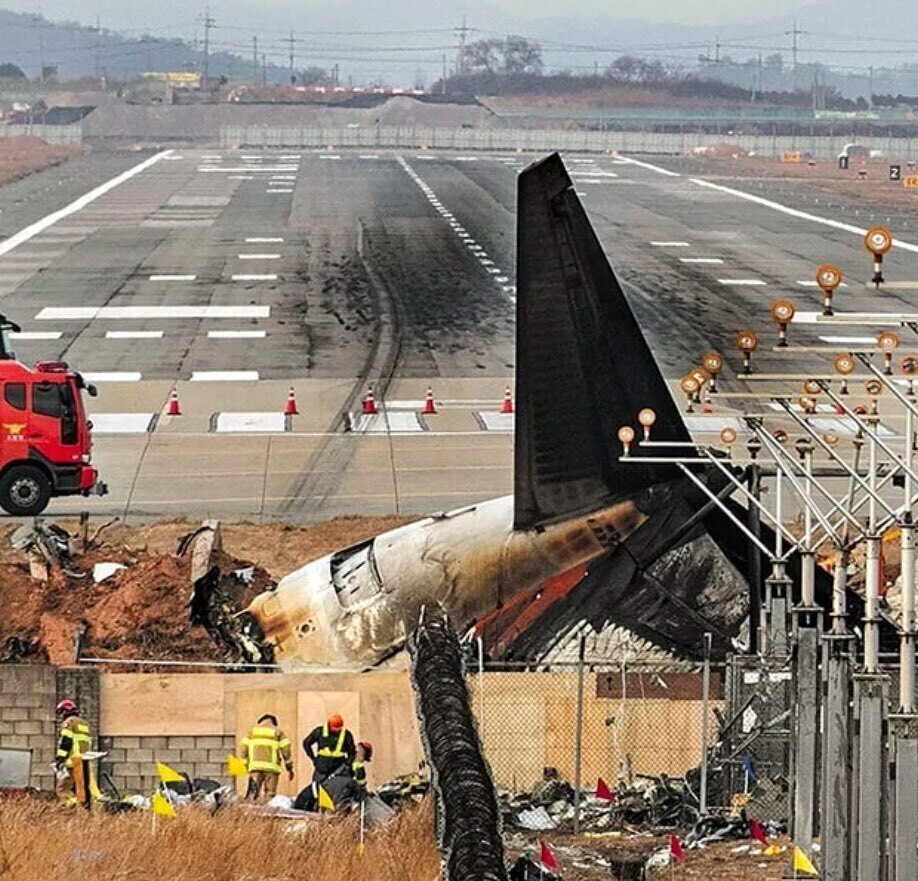
国土交通部によると、該当ローカライザーは2007年務安空港開港当時から(幅0.26メートル・高さ3メートルのコンクリート柱19本を使用した)高さ1.8メートルの丘の上に設置されたことが把握された。その後、韓国空港公社が2020年5月に務安空港のローカライザー改良事業を始め、2023年9月~昨年2月に既存のコンクリート柱19個の一部を削り、その上に厚さ0.3メートル・幅42メートル・奥行3.4メートルのコンクリート上板を追加で重ねたことが分かった。
追記
バードストライクによる両エンジンの不調や停止にもかかわらず安全(?)に着陸・不時着した事例としては、ライアンエアー4102便の事故(着陸直前)(ローマの奇跡、着陸復行・ゴーアラウンドを試みるも、失速し、滑走路にハードランディング)、ハドソン川の奇跡(離陸直後)、ラメンスコエ(とうもろこし畑)の奇跡(離陸直後)等が知られています。

朝鮮日報・2025/01/01
ライアンエアー4102便の事故を受けて、イタリア国家航空安全機関ANSVは乗務員の訓練やガイドラインに以下の内容を含めるよう勧告
— 草F1 (@MADCOINX) January 5, 2025
・最終進入段階で鳥衝突が発生した場合、着陸が確実であればゴーアラウンド手順を実行するのではなく、可能な限りエンジン出力を最低に設定して着陸することが望ましい…
エアバスは最終進入中に鳥衝突に遭遇した場合は着陸の継続を推奨している
— 草F1 (@MADCOINX) January 5, 2025
理由は単純で、機体のダメージが不明な以上は、無事に着陸をやり直せる保証が無いから
その逆をやった事故が2008年のライアンエアー4102便… https://t.co/X1UdQHesyU pic.twitter.com/F7Bmjjykyy
【 Google 翻訳 】
Re: 181人を乗せた韓国のジェット機が空港で墜落
当スレッドのコメントをいくつか読み、まとめて返信しようと思いました。
現時点でほとんどの人が推測できる最もありそうなSOE(一連の出来事)
機体は北向きに滑走路(RWY 01)へ向かって最終アプローチ中、鳥の群れに遭遇し、鳥との衝突で第2エンジンが故障しました。
・パイロットはエンジン故障のため推力を減らしてゴーアラウンドを開始しました。状況を考えると、これが最も適切な選択肢だったと思われます。目撃者は上昇中に目に見えるほどの苦労を報告しています。
・方向転換してすぐに南向きの着陸を試みるという決定が下されました。機体の性能が低下していることを示唆しています。
・但し、これが非常に重要ですが、ゴーアラウンド中に片方のエンジンで実行された急旋回は油圧を含む操縦翼面が機能していたことを示しています。実行された旋回を確認するには、下の進入チャートを参照してください。
・タッチダウンが近づき、乗員は着陸装置が展開されていないことに気が付きました。[*1]
・パイロットは着陸を中止しようとエンジン出力を上げ、抗力(抵抗)を減らすためにおそらく他の操縦翼面を引き込んだでしょう。[*2]
・残るエンジンの推力が限られており、短い時間に対応しなければならなかったことも相まって、機体は十分に高度を上げることができませんでした。
・機体は着陸装置を引き込んだ状態で滑走路に接触し、数分前に加えられた推力により、滑走路を滑る速度が増しました。
上記のSOEには2 つの大きな疑問(*1 と *2 で強調表示)があります。
1.フラップが開かれているのにランディングギアが降ろされロックされていない場合、非常によく聞こえるギアダウン警告が鳴ります。但し、コックピットのストレスにより警告が聞き逃されるという事例はこれまでにも数多くあり、最も有名なのは AF447 のケースの「失速」警告です。コックピットでは降下中ずっと失速警告が鳴っていたのに、見過ごされました。
2.もう 1 つの問題は、773-800 の場合、SOP(標準操作手順)は進入復行に際してフラップを15度にし、完全に格納しないことです。
パイロットがフラップも、スラットも、スピードブレーキも、着陸装置も忘れたとは思いません。これらは、文字通り、航空機を着陸用にセットアップする最も重要な事項です。せいぜい着陸装置を忘れただけでしょう。
着陸時に翼に残っていた燃料
シミュレーションされた飛行の燃料計画をご覧ください。搭載する燃料はおよそ18,000 kgで、そのうち13,500 kgは飛行とタキシングに使用されます。
機体にはまだ4,000 kg残っています。(ゴーアラウンドが実行された場合は3,000 kg。)火球(大爆発)を引き起こすのに十分な量です。
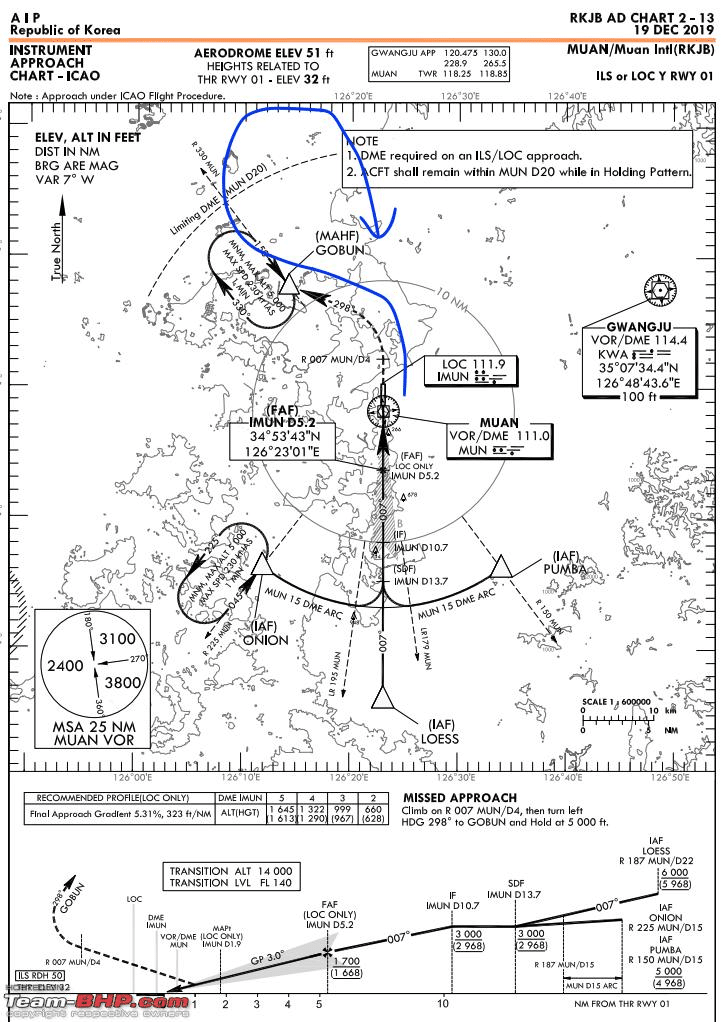
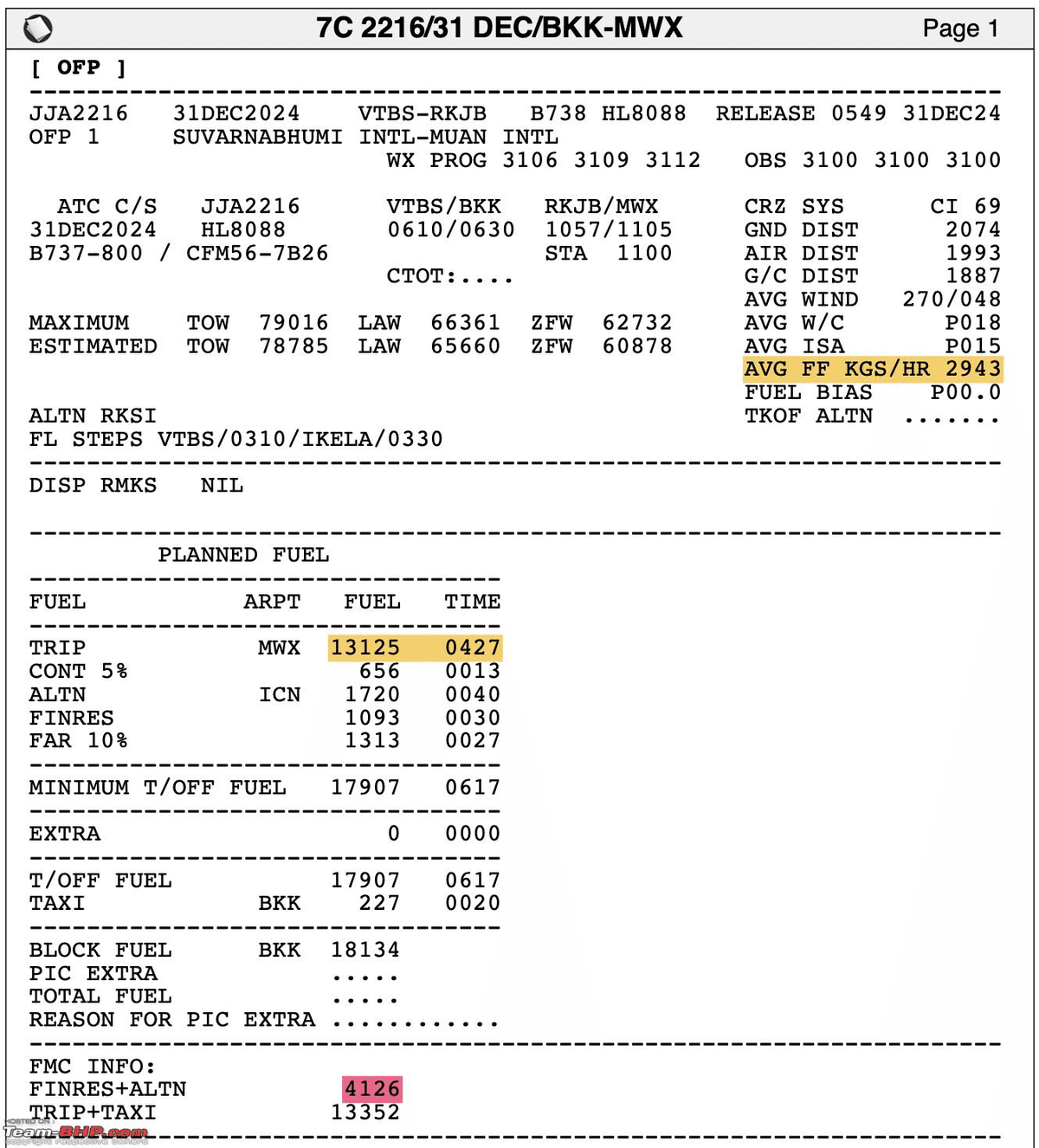
【 原文 】
1st January 2025 - 02:55
iceman.
Joined: July 2018
Location: Bangalore
Re: South Korean Jet carrying 181 people crashes at airport
I read through some comments in the thread, thought of responding in one go.
Most plausible SOE (Sequence of Events) that most of us can speculate at the moment
Aircraft was on final approach heading northbound (RWY 01) when it encountered a flock of birds, resulting in a bird strike that disabled engine #2.
- Pilots initiated a go-around with reduced thrust due to engine failure - given the situation, this was likely the most appropriate option. Eyewitnesses reporting visible struggle during the climb.
- A decision was made to reverse direction and attempt an immediate southbound landing, suggesting the aircraft's performance was deteriorating.
- However - and this is very important - The tight turn executed with single engine during the go-around indicated that control surfaces, including hydraulics, were operational. Take a look at the approach chart below to see the executed turn.
- As the aircraft neared touchdown, the crew realized the landing gear had not been deployed. [*1]
- Pilots increased engine power in an attempt to abort the landing, possibly retracting other control surfaces to reduce drag. [*2]
- The remaining engine’s limited thrust, combined with the short reaction window, prevented the aircraft from regaining sufficient altitude.
- The aircraft impacted the runway with landing gear retracted, sliding down the surface at increased speed due to the thrust applied moments earlier.
Now there are two major questions with the above SOE (highlighted as bold *1 and *2).
1. There will be a very audible gear down warning if aircraft is configured dirty and LG is not engaged and locked. However, we have had numerous incidents earlier where warnings are missed due to stress in the cockpit, the most famous being the "Stall" warning in the AF447 case. That cockpit was blaring the stall warning the entire descent and yet overlooked.
2. The other issue is that for a 738, the SOP is flaps 15 for a missed approach, not full retraction.
What I will probably not accept is that the pilots forgot flaps, slats, speed brakes and also the landing gear - I mean those are literally the most important things you do to setup an aircraft for landing. At most, they forgot only the landing gear.
Fuel Remaining in wings at the time of landing
Please see below the simulated fuel planning for the flight - approx. total fuel would be 18,000 kgs - out of which 13,500 would have been used for trip + taxi.
The aircraft would still have 4,000 kgs (or 3,000 if a go-around was executed). This is enough to cause a fireball.
